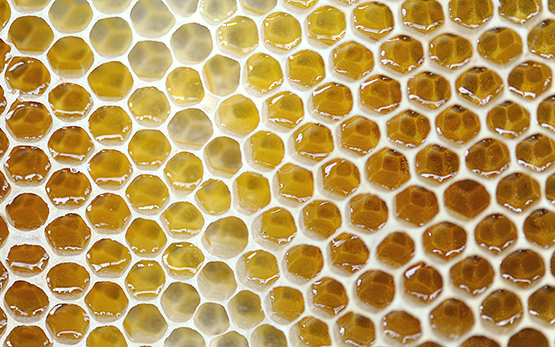Der Wassergehalt des von den Pflanzen produzierten Nektars kann variieren. Um seine Konservierung in den Waben zu gewährleisten, darf er nicht gären. Deshalb wird er von den Bienen in Honig umgewandelt, indem sie seinen Wassergehalt senken und folglich den Zuckergehalt erhöhen. Dies verhindert die Entwicklung der Mikroorganismen. In der Dunkelheit des Bienenstocks ist es schwierig, den Herstellungsprozess des Honigs zu beobachten. Aus diesem Grund ist er auch nur wenig erforscht. Um die Umwandlung von Nektar in Honig zu untersuchen, haben wir die Technik der Tomographie eingesetzt. Sie ermöglicht es, den Zuckergehalt des eingelagerten Nektars sehr präzise zu messen, ohne den Bienenstock öffnen zu müssen und das Bienenvolk zu stören.

Publications Benjamin Dainat
Guichard M., Dainat B., Dietemann V.
Natürliche Selektion - ein Wundermittel gegen die Varroamilbe?
Schweizerische Bienen-Zeitung, 9, 2023, 23-27.
Ory F., Dietemann V., Guisolan A., Von Ah U., Fleuti C., Oberhaensli S., Charrière J.-D., Dainat B.
Paenibacillus melissococcoides sp. nov., isolated from a honey bee colony affected by European foulbrood disease.
International Journal of Systematic and Evolutionary Microbiology, 73, (4), 2023, 1-10.
Charrière J.-D., Dietemann V., Dainat B.
Guide de la santé de l’abeille : Edité par le Centre de recherche apicole.
Agroscope Transfer, 502, 2023, 1-45.
autres langues: allemand | italien
Dainat B., Oberhaensli S., Ory F., Dietemann V.
New reference genomes of honey bee-associated bacteria Paenibacillus melissococcoides, Paenibacillus dendritiformis, and Paenibacillus thiaminolyticus.
Microbiology Resource Announcements, In Press, 2023, 1-4.
Guichard M., Dainat B., Dietemann V.
La sélection naturelle – une solution miracle face au varroa?
Revue Suisse d'apiculture, 144, (7), 2023, 287-292.
Guichard M., Dainat B., Dietemann V.
Prospects, challenges and perspectives in harnessing natural selection to solve the ‘varroa problem’ of honey bees.
Evolutionary Applications, 16, (3), 2023, 593-608.
Gmel A., Guichard M., Dainat B., Rhys Williams G., Eynard S., Vignal A., Servin B., the Beestrong Consortium, Neuditschko M.
Identification of runs of homozygosity in Western honey bees (Apis mellifera) using whole-genome sequencing data.
Ecology and Evolution, 13, (1), 2023, 1-13.
Guichard M., Phocas F., Neuditschko M., Basso B., Dainat B.
An overview of selection concepts applied to honey bees.
Bee World, 100, (1), 2023, 2-8.
Guichard M., von Virag A., Dainat B.
Evaluating the potential of brood recapping to select varroa destructor (Acari: Varroidae) resistant honey bees (Hymenoptera: Apidae).
Journal of Economic Entomology, 116, (1), 2023, 56-67.
Eynard S., Vignal A., Agez Y., Basso B., Bouchez O., Bulach T., Le Conte Y., Dainat B., Decourtye L., Guichard M., Guillaume F., Labarthe E., Mahla R., Mondet F., Neuditschko M. et autres
Statistics for an accurate genome wide association study on Varroa resistance trait in a French honeybee.
Dans: Proceedings of 12th World Congress on Genetics Applied to Livestock Production (WCGALP). Ed. R.F. Veerkamp and Y. de Haas, Wageningen Academic Publishers. 2022, 2568-2571.
von Virag A., Guichard M., Neuditschko M., Dietemann V., Dainat B.
Sélectionner des colonies avec une faible reproduction du varroa ?
Revue Suisse d'apiculture, 11-12, 2022, 504-507.
autres langues: allemand
de la Harpe M., Guetlin A., Chiang C., Dietemann V., Dainat B.
Influence of honey bee nutritive jelly type and dilution on its bactericidal effect on Melissococcus plutonius, the etiological agent of european foulbrood.
Microbial Ecology, 2022, 1-7.
Ory F., Duchemin V., Kilchenmann V., Charrière J.-D., Dainat B., Dietemann V.
Can trans-generational immune priming be used to protect honey bees against European foulbrood.
Dans: EurBee 9 – 9th European Congress of Apidology. 20-22 September, Ed. EurBee, Belgrade. 2022, 97.
Ameline C., Beaurepaire A., Ory F., de la Harpe M., Dainat B., Dietemann V.
Differential resistance across paternal genotypes of honey bee brood to the pathogenic bacterium Melissococcus plutonius.
Journal of Applied Entomology, online, (6 October), 2022, 1-9.
von Virag A., Guichard M., Neuditschko M., Dietemann V., Dainat B.
Suppressed mite reproduction SMR: An efficient tool to select Varroa destructor resistant honey bee?
Dans: 69. Jahrestagung der Arbeitsgemeinschaft der Institute für Bienenforschung e.V.. 5. - 7. April, Ed. Universität Hohenheim, Bad Überkingen-Oberböhringen. 2022.
Charrière J.-D., Dietemann V., Kast C., Droz B., Dainat B., Grossar D., Jeker L.
Que s’est-il passé au Centre de recherche apicole en 2021 ?
Revue Suisse d'apiculture, 143, (8), 2022, 337-348.
autres langues: allemand
Charrière J.-D., Dietemann V., Kast C., Droz B., Dainat B., Grossar D., Jeker L.
Que s’est-il passé au Centre de recherche apicole en 2021?
Agroscope Transfer, 447, 2022, 1-15.
autres langues: allemand | italien
von Virag A., Guichard M., Neuditschko M., Dietemann V., Dainat B.
Decreased Mite Reproduction to Select Varroa destructor (Acari: Varroidae) Resistant Honey Bees (Hymenoptera: Apidae): Limitations and Potential Methodological Improvements.
Journal of Economic Entomology, 115, (3), 2022, 695-705.
Franco S., Cougoule N., Tison A., Del Cont A., Gastaldi C., ILC Consortium, Dainat B., Duquesne V.
Reliability of Morphological and PCR Methods for the Official Diagnosis of Aethina tumida (Coleoptera: Nitidulidae): A European Inter-Laboratory Comparison.
Insects, 13, (33), 2022, 1-20.
Guichard M., Dainat B., Neuditschko M.
Le séquençage du génôme des colonies d'abeilles mellifères permet d'identifier des gènes influençant des caractères d'élevage.
Revue Suisse d'apiculture, 3, 2022, 107-111.
autres langues: allemand





